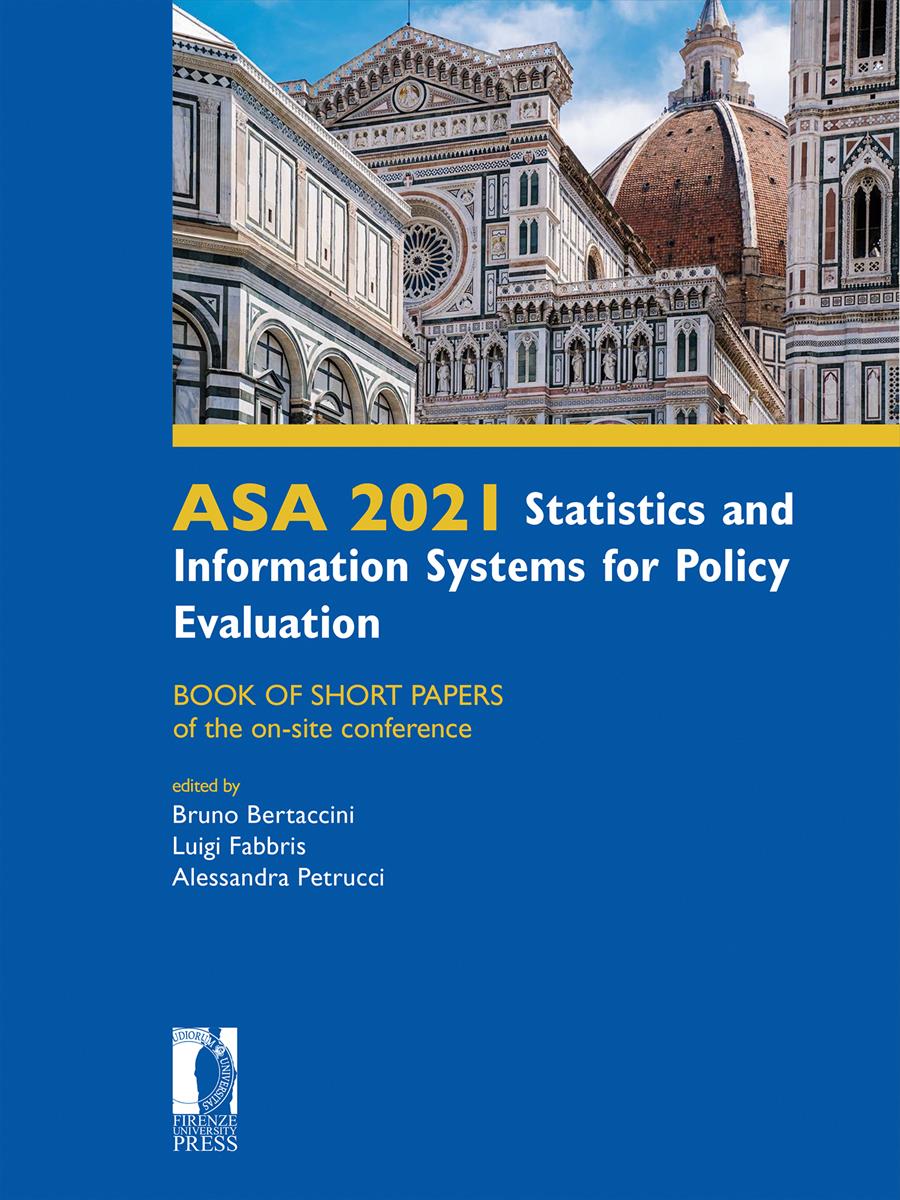- ASA 2021 Statistics and Information Systems for Policy Evaluation
- Edited by Bruno Bertaccini, Luigi Fabbris, Alessandra Petrucci
Determinants of the transition to upper secondary school: differences between immigrants and Italians
- Patrizio Frederic
- Michele Lalla
- © 2021 Author(s) |
- CC BY 4.0
- DOI: 10.36253/978-88-5518-461-8.04
The determinants of the transition from lower secondary to upper secondary school of Italian and immigrant teenagers (16-19 age range) were identified joining the European Union Statistics on Income and Living Conditions (EU-SILC) and the Italian Survey on Income and Living Conditions of Families with Immigrants in Italy (IM-SILC) for 2009. A set of individual, family, and contextual characteristics was selected through the Lasso method and a Bayesian approach to explain the choice of upper secondary schooling (yes/no). The transition from the low secondary to upper secondary school showed a complex pattern involving many variables: compared to men, women did not prove to have any differences, many components of income entered the model in a parabolic form, education level and income of parents proved to be very important, as was their occupation. The contextual factors revealed their importance: the latter included the degree of urbanisation, the South macro-region, household tenure status, the amount of optional technological equipment, and so on. Differences between Italians and immigrants disappeared when family background and parental characteristics were taken into account.
- Keywords:
- Lower-to-upper,
- secondary transition,
- school-to-work,
- transition,
- educational inequality,
- parents’ effects on education,
- Lasso method,
University of Modena and Reggio Emilia, Italy - ORCID: 0000-0001-9073-2878
University of Modena and Reggio Emilia, Italy - ORCID: 0000-0002-1639-7300
- Bertolini, P., Lalla, M. (2012). Immigrant Inclusion and Prospects through Schooling in Italy: An Analysis of Emerging Regional Patterns, in Punishing Immigrants: Policy, Politics and Injustice, eds. C. E. Kubrin, S. Marjorie, R. M. Jr. Zatz, New York University Press, New York (pp. 178-206).
- Bertolini, P., Lalla, M., Pagliacci, F. (2015). School enrollment of first- and second-generation immigrant students in Italy: A geographical analysis, Papers in Regional Science, 94(1), pp. 141-160.
- Eurostat (2009). Description of Target Variables: Cross–section and Longitudinal, EU–SILC 065 (2009 operation), Directorate F, Unit F–3, Eurostat, Luxembourg.
- Forster, A.G., van de Werfhorst, H.G. (2020). Navigating Institutions: Parents’ Knowledge of the Educational System and Students’ Success in Education, European Sociological Review, 36(1), pp. 48-64.
- Friedman, J., Hastie, T., Tibshirani, R. (2010). Regularization Paths for Generalized Linear Models via Coordinate Descent, Journal of Statistical Software, 33(1), pp. 1-22.
- Ichou, M., Wallace, M. (2019). The Healthy Immigrant Effect: The role of educational selectivity in the good health of immigrants, Demographic Research, 40(4), pp. 61-94.
- Istat (2008). Ceccarelli C., Di Marco M., and Rinaldelli C. (Eds.). L’indagine europea sui redditi e le condizioni di vita delle famiglie (Eu-Silc). Metodi e Norme n. 37, Istat, Rome.
- Istat (2009). Reddito e condizioni di vita delle famiglie con stranieri [electronic resource]. Istat, Rome. https://www.istat.it/it/archivio/52405. Accessed 3 January 2020.
- Krause, A., Rinne, U., Schüller, S. (2015). Kick it like Özil? Decomposing the native-migrant education gap, International Migration Review, 49(3), pp. 757-789.
- Lalla, M., Frederic, P. (2020). Tertiary education decisions of immigrants and non-immigrants in Italy: an empirical approach, DEMB Working Papers Series, N. 168, pp. 1-39. University of Modena and Reggio Emilia - Department of Economics.
- Ochsen, C. (2011). Recommendation, class repeating, and children’s ability: German school tracking experiences, Applied Economics, 43(27), pp. 4127-33.
- R Core Team (2019). R: A language and environment for statistical computing, R Foundation for Statistical Computing, Vienna (AT). URL http://www.R-project.org/. Accessed 18 April 2020.
- Tibshirani, R. (1996). Regression shrinkage and selection via the lasso, Journal of the Royal Statistical Society, Series B, 58(1), pp. 267-288.
- Zou, H., Hastie, T., & Tibshirani, R. (2007). On the degrees of freedom of the lasso, The Annals of Statistics, 35(5), pp. 2173-2192.
Chapter Information
Chapter Title
Determinants of the transition to upper secondary school: differences between immigrants and Italians
Authors
Patrizio Frederic, Michele Lalla
Language
English
DOI
10.36253/978-88-5518-461-8.04
Peer Reviewed
Publication Year
2021
Copyright Information
© 2021 Author(s)
Content License
Metadata License
Bibliographic Information
Book Title
ASA 2021 Statistics and Information Systems for Policy Evaluation
Book Subtitle
BOOK OF SHORT PAPERS of the on-site conference
Editors
Bruno Bertaccini, Luigi Fabbris, Alessandra Petrucci
Peer Reviewed
Publication Year
2021
Copyright Information
© 2021 Author(s)
Content License
Metadata License
Publisher Name
Firenze University Press
DOI
10.36253/978-88-5518-461-8
eISBN (pdf)
978-88-5518-461-8
eISBN (xml)
978-88-5518-462-5
Series Title
Proceedings e report
Series ISSN
2704-601X
Series E-ISSN
2704-5846
